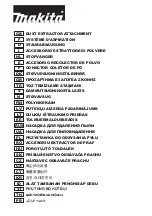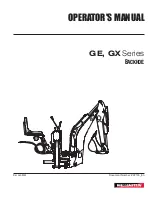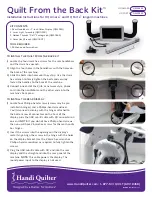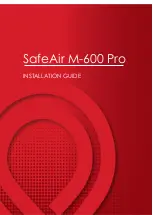
4
LA-03 MODEL AWNING INSTALLATION INSTRUCTIONS
4.
INSTALLATION PROCEDURE
a.
The mounting bracket plates must be installed at the
same height horizontally with respect to each other. Use
a chalk line to mark a level line for the bottom edge of the
mounting bracket plates.
b.
Determine the distance between the mounting bracket
plates from chart on page 3. Mark the location for the
mounting bolts using the mounting bracket plate as a
template. See FIG. 3.
c.
Use a 7/16” drill to bore the holes in the coach wall for the
mounting bolts.
d.
Apply silicone sealant around each mounting bolt hole
and to each mounting bolt before it is inserted into the
hole. This will prevent water leaks through the side wall.
e.
Place the flat backer plate over each group of three
mounting bolts, a flat washer on each bolt and, secure
with a lock nut. See FIG. 4.
f.
Tighten all six of the mounting bolts evenly to a torque of
33 foot pounds (minimum).
b.
Solid structure in the coach wall for mounting of the
mounting bracket plates is required and for supporting
the awning weight. (Mounting Bracket Location Chart
and See FIG. 3 on page 3)
Note: A installer supplied (5-3/8" x 3-3/4" x 1/8") flat
plate that matches the 3 bolt pattern of the mounting
bracket is placed inside of the coach. The 6 hole
mounting bracket plate goes on the outside. Solid
structure within the wall is required for support of the
awning weight. See FIG. 4 & 4A.
c.
The control box should be mounted in a compartment or
location near the right hand end of the awning, where it
can be easily reached for service and connecting of the
wiring. See FIG. 9.
d.
Install an AC Power GFI (Ground Fault Interrupter)
receptacle (not supplied) within reach of the 6' power
cord of the awning control box.See FIG. 9.
e.
Install a recessed AC outlet box (FS type outside water
tight, not supplied) to supply power to the awning motor.
The electrical outlet box cover must be flush with the side
wall of the coach. It must be a minimum of 1-1/8" away
from the awning RH end plate, but not more than 1-1/4"
maximum. It must be 3-1/8 " down from the top of the
awning case. See FIG. 9 & 9A.
5.
PLACING AWNING ON MOUNTING BRACKETS
Note: Make sure all of the mounting brackets are
properly tightened. See Step 4 paragraph f.
a.
A mechanical hoist is recommended to be used in the
installation of this awning. If the awning must be lifted by
hand, use a minimum of 4 persons, always wear back
braces and use proper lifting technique.
b.
Place the awning in an upright position above the
mounting brackets. Allow the awning to slide straight
down catching the two mounting flanges on the back of
the casing in the matching two flanges on the mounting
brackets. See FIG. 5.
c.
Visually inspect the awning to make sure the mounting
brackets are positioned behind each of the lateral arms
The unit weighs approximately 288 pounds.
To prevent back injury, use a mechanical
hoist to place awning on mounting brackets.
WARNING
!
shoulder brackets. Make sure the Awning is hooked on
all mounting brackets. If awning is not caught by the
bracket, determine the problem and correct, The aw-
ning must be fully seated on all mounting brackets
flanges. See FIG. 5.
FIG. 4
Place The Flat
Backer Plates Over
The Bolts
Place Flat Washer
& Lock Nuts Over
The Bolts
BACK UP PLATE
5-3/8” x
1/8”
3-3/4” x
4-3/8”
1-3/8”
1-3/8”
3 HOLES
7/16” DIA.
FIG. 4A
Lock
Mechanism
FIG. 5
Catch Two
Flanges on
Mounting
Bracket
Two Flanges
on Mounting
Bracket




























